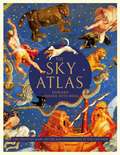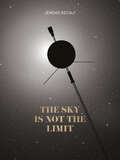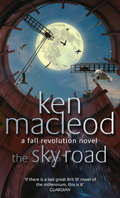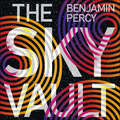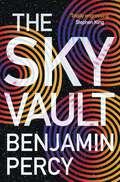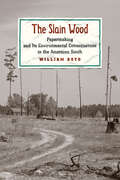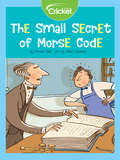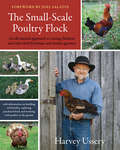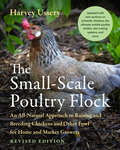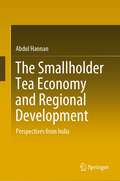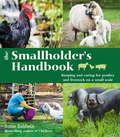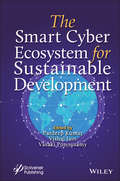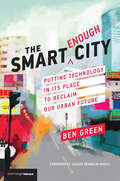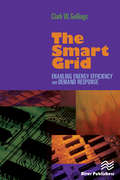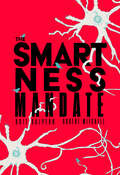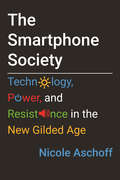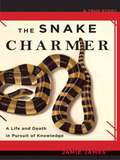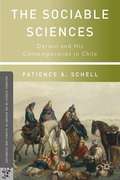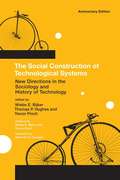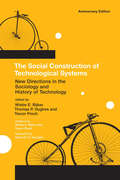- Table View
- List View
The Sky Atlas: The Greatest Maps, Myths and Discoveries of the Universe
by Edward Brooke-HitchingAfter the enormous international success of The Phantom Atlas and The Golden Atlas, Edward Brooke-Hitching's stunning new book unveils some of the most beautiful maps and charts ever created during mankind's quest to map the skies above us. This richly illustrated treasury showcases the finest examples of celestial cartography - a glorious genre of map-making often overlooked by modern map books - as well as medieval manuscripts, masterpiece paintings, ancient star catalogues, antique instruments and other appealing curiosities. This is the sky as it has never been presented before: the realm of stars and planets, but also of gods, devils, weather wizards, flying sailors, medieval aliens, mythological animals and rampaging spirits. The reader is taken on a tour of star-obsessed cultures around the world, learning about Tibetan sky burials, star-covered Inuit dancing coats, Mongolian astral prophets and Sir William Herschel's 1781 discovery of Uranus, the first planet to be found since antiquity. Even stranger are the forgotten stories from European history, like the English belief of the Middle Ages in ships that sailed a sea above the clouds, 16th-century German UFO sightings and the Edwardian aristocrat who mistakenly mapped alien-made canals on the surface of Mars.As the intricacies of our universe are today being revealed with unprecedented clarity, there has never been a better time for a highly readable book as beautiful as the night sky to contextualise the scale of these achievements for the general reader.
The Sky Is Not the Limit
by Jérémie DecalfA poetic odyssey through space with the groundbreaking Voyager 2 probe—past Earth, into deep space and beyond.In 1977, a space probe was built to help human beings learn a little more about outer space. Soon, along with its twin, Voyager 2 slipped through the clouds and left Earth behind. The spacecraft traveled for years through the deep, infinite night. At last Voyager 2 reached its first goal: Jupiter. Then it met the spellbinding sight of Saturn. Then, going further than any previous mission, the probe visited the blue ice giants Uranus and Neptune. Past the boundaries of our solar system, Voyager 2 sails on, carrying a Golden Record for any new friends it makes in interstellar space…This lyrical, atmospheric book introduces young readers to a pioneering NASA spacecraft that has spent over forty-five years observing and exploring our galaxy. With stirring poetry, luminous art, and fascinating back matter, The Sky Is Not the Limit will inspire future scientific innovators and foster a sense of wonder at our universe.
The Sky Road: Book Four: The Fall Revolution Series (Fall Revolution Ser. #4)
by Ken MacLeod'Exciting...Accessible to the average reader as well as the hardcore SF fan. This is a work sure to keep the reader on the edge of her seat.' - Romantic Times Bookclub'For my money, Ken MacLeod is the current champion of the very smartest kind of New Space Opera... every variation on his themes produces something worth re-reading.' - LocusCenturies after its catastrophic Deliverance, humanity is again reaching into space. And one young scholar working in the space ship yard, Clovis colha Gree, could make the difference between success and failure. For his mysterious lover, Merrial, has seduced him into the idea of extrapolating the ship's future from the dark archives of the past.A past in which, centuries before, Myra Godwin faced the end of a different space age - her rockets redundant, her people rebellious, and her borders defenceless against the Sino-Soviet Union. As Myra appealed to the falling empires of the West for help, she found history turning on her own dubious past - and on her present decisions. Decisions which, centuries later, will determine the future of the new space age. Merrial's people, the itinerant computer engineers, know this. And they know that the truth they seek lies within the secret files left by Myra Godwin.Set hundreds of years in the future, THE SKY ROAD is the astonishing story of the dawn of a new space age, from the most exciting British SF author to have emerged in recent years.Books by Ken MacLeod:Fall RevolutionThe Star FractionThe Stone CanalThe Cassini DivisionThe Sky RoadEngines of LightCosmonaut KeepDark LightEngine CityCorporation Wars TrilogyDissidenceInsurgenceEmergenceNovelsThe Human FrontNewton's WakeLearning the WorldThe Execution ChannelThe Restoration GameIntrusionDescent
The Sky Road: Book Four: The Fall Revolution Series (Fall Revolutions #4)
by Ken MacLeod'Exciting...Accessible to the average reader as well as the hardcore SF fan. This is a work sure to keep the reader on the edge of her seat.' - Romantic Times Bookclub'For my money, Ken MacLeod is the current champion of the very smartest kind of New Space Opera... every variation on his themes produces something worth re-reading.' - LocusCenturies after its catastrophic Deliverance, humanity is again reaching into space. And one young scholar working in the space ship yard, Clovis colha Gree, could make the difference between success and failure. For his mysterious lover, Merrial, has seduced him into the idea of extrapolating the ship's future from the dark archives of the past.A past in which, centuries before, Myra Godwin faced the end of a different space age - her rockets redundant, her people rebellious, and her borders defenceless against the Sino-Soviet Union. As Myra appealed to the falling empires of the West for help, she found history turning on her own dubious past - and on her present decisions. Decisions which, centuries later, will determine the future of the new space age. Merrial's people, the itinerant computer engineers, know this. And they know that the truth they seek lies within the secret files left by Myra Godwin.Set hundreds of years in the future, THE SKY ROAD is the astonishing story of the dawn of a new space age, from the most exciting British SF author to have emerged in recent years.Books by Ken MacLeod:Fall RevolutionThe Star FractionThe Stone CanalThe Cassini DivisionThe Sky RoadEngines of LightCosmonaut KeepDark LightEngine CityCorporation Wars TrilogyDissidenceInsurgenceEmergenceNovelsThe Human FrontNewton's WakeLearning the WorldThe Execution ChannelThe Restoration GameIntrusionDescent
The Sky Vault: The Comet Cycle Book 3 (The Comet Cycle #2)
by Benjamin PercyThe third and final book in Percy's innovative and acclaimed Comet Cycle, The Sky Vault follows the aftermath of an airplane that goes missing over Fairbanks, Alaska, in the wake of the comet, and a teenager's search for answers about his father's final moments aboard the flight.The comet, Cain, came from beyond our solar system, its debris containing elements unknown. It brought a powerful new metal to the once-declining Midwest; alien fungus to the forests of the Pacific Northwest; and now, in the isolated region of Fairbanks, Alaska, the skies shift and stretch as an interstellar dust cloud seeds itself in the atmosphere. The National Weather Service dismisses the anomaly. Then, an hour outside of Fairbanks, a plane shudders its way through pulpy, swirling, bruise-shaped clouds, lit with sudden cracks of lightning. The sky opens. And the plane vanishes.Theo Jenson is fifteen years old when his father inexplicably disappears along with the plane, and the month-long search for him ends with a funeral procession and the beginnings of acceptance. Despite the tragedy, Theo's popularity in school skyrockets, while his best friend Wheezy remains on the outskirts of any real social circle. Their friendship will be put to the test when other Fairbanks citizens begin to vanish, sucked up by a funnel cloud that extends like an elephant's trunk, and chased down by a mist that solidifies into the shape of a man.Most comets, it's generally believed, are made of a combination of rock and ice. But the fact that so many of them blink out of existence - seen one day, gone the next - makes some scientists believe they are cored with something known as "mirror matter," another term for the dark matter we know exists in the universe because of its gravitational force. The effects of Cain's dark matter are still not entirely known, but its impact on Earth might be more treacherous, or sublime, than could ever be imagined.(P) 2023 HarperCollins Publishers
The Sky Vault: The Comet Cycle Book 3 (The Comet Cycle #2)
by Benjamin Percy'Totally engrossing' - STEPHEN KING on The Ninth MetalTHE FINAL BOOK IN PERCY'S CRITICALLY CLAIMED COMET CYCLE SERIES!The comet, Cain, came from beyond our solar system, its debris containing elements unknown. Now, in the isolated region of Fairbanks, Alaska, the skies shift and stretch as an interstellar dust cloud seeds the atmosphere. When a plane shudders its way through pulpy, swirling, bruise-shaped clouds, lit with sudden cracks of lightning, the sky opens and the aircraft vanishes...but only for a minute.When the flight lands, everyone on board and in the community will be changed forever. Chuck Bridges, a local DJ and conspiracy theorist, was on board and later reported dead to his family, but not before proclaiming that something inside the clouds was speaking to him. Now his son, Theo, must chase down answers to the mystery his father unlocked. He'll find himself at odds with Sophie Chen, an agent with a shadowy employer desperate to secure the black box from the airplane, as well as Rolf Wagner, a widowed sheriff investigating a series of increasingly strange and unsettling reports. And then there is Joanna Straub, a contractor reconstructing a top-secret government lab active during WWII and shuttered deep within the nearby White Mountains.The answer to the comet's origin is about to be unveiled, and its impact on Earth is more treacherous and sublime than humanity could imagine.'Take one part dystopia, one part sci-fi, two parts apocalypse, then ride them roughshod through a bleak and bloody western, and it still wouldn't get close to what Ben Percy does here, which is blow open the core of humanity's dark heart.' - Marlon James, Booker Prize-winning author of Black Leopard, Red Wolf, on The Ninth Metal 'The Stephen King of science fiction.' - Margaret Stohl, New York Times bestselling author, on The Ninth Metal'Audacious and intelligent and exactly what I was dying to read.' - Victor LaValle, author of The Changeling, on The Ninth Metal'This standout combination of science and psychology is sure to wow SF fans.' Publishers Weekly (starred review)
The Slain Wood: Papermaking and Its Environmental Consequences in the American South (Studies in Industry and Society)
by William BoydThe paper industry rejuvenated the American South—but took a heavy toll on its land and people.When the paper industry moved into the South in the 1930s, it confronted a region in the midst of an economic and environmental crisis. Entrenched poverty, stunted labor markets, vast stretches of cutover lands, and severe soil erosion prevailed across the southern states. By the middle of the twentieth century, however, pine trees had become the region’s number one cash crop, and the South dominated national and international production of pulp and paper based on the intensive cultivation of timber.In The Slain Wood, William Boyd chronicles the dramatic growth of the pulp and paper industry in the American South during the twentieth century and the social and environmental changes that accompanied it. Drawing on extensive interviews and historical research, he tells the fascinating story of one of the region’s most important but understudied industries. The Slain Wood reveals how a thoroughly industrialized forest was created out of a degraded landscape, uncovers the ways in which firms tapped into informal labor markets and existing inequalities of race and class to fashion a system for delivering wood to the mills, investigates the challenges of managing large papermaking complexes, and details the ways in which mill managers and unions discriminated against black workers. It also shows how the industry’s massive pollution loads significantly disrupted local environments and communities, leading to a long struggle to regulate and control that pollution.
The Small Secret of Morse Code
by Pamela DellWant to know about the dots and dashes of Morse code? Learn how Morse code came into being and became less time-consuming and more efficient.
The Small-Scale Poultry Flock
by Harvey UsseryAn All-Natural Approach to Raising Chickens and Other Fowl for Home and Market Growers
The Small-Scale Poultry Flock, Revised Edition: An All-Natural Approach to Raising and Breeding Chickens and Other Fowl for Home and Market Growers
by Harvey UsseryThe most comprehensive book on how to raise and breed your own poultry flock is now fully updated and expanded&“The ultimate book for those who want to know everything there is to know about raising poultry.&”—Gene Logsdon, author of Letter to a Young Farmer&“There&’s no better introductory reference on the joy of home-raising chickens.&”—Booklist The first edition of The Small-Scale Poultry Flock helped thousands of small-scale farmers and homesteaders successfully adopt a practical and integrative model for working with chickens and other domestic fowl based on natural systems. In this expanded and thoroughly revised edition, readers will find plenty of all-new material. Author Harvey Ussery introduces readers to his new favorite breed of chicken, Icelandics; describes how he manages his breeding flock using a clan mating system; presents detailed information on the use of trapnests and record-keeping spreadsheets for evaluating breeding hen performance; and provides step-by-step instructions for construction of an ingeniously designed mobile poultry shelter.Readers will also find fully updated information and tips on all aspects of flock management, including:Growing (and sourcing) feed on a small scaleCultivating earthworms and grubs as high-protein poultry feedBrooding (and breeding) at homeImplementing manure managementUsing electric net fencing for ranging flocksUsing poultry as insect and weed managers in the garden and orchardEnlisting your chickens as garden tillers and compost-makersProtecting the flock from predatorsKeeping the flock healthyWorking with mother hensUssery presents a sustainable and ecologically friendly model that can be adapted for use at a variety of scales. His advice and examples throughout the book will prove invaluable for beginner homesteaders, growers looking to incorporate poultry into their farm, or experienced flocksters seeking to close their loop.
The Smallholder Tea Economy and Regional Development: Perspectives from India
by Abdul HannanThis book discusses the smallholder tea economy and regional development opportunities in India. It first gives a conceptual overview of Plantations and Smallholders in the Tea Economy including some comparisons and examples from Smallholders tea development in Afro-Asian countries like Sri Lanka, Kenya, Nepal, Bangladesh, Indonesia. The spatiotemporal analysis of the growth and development of smallholders in India and its tea producing states is then analyzed in more detail with highlights on the production, tea area, estimated employment, livelihood pattern, and market structure in relation to government policies and programmes. Two major tea producing states of India, i.e., Assam and West Bengal are then discussed in more detail (farm size, land relations, and trade relations between Bought Leaf Factories and Smallholders in both the states along with some bottom-up development initiatives). In these regions, smallholders have emerged as sizable presences in the tea industry in 1990s. In a next step, the growth of Industrial Development Cooperative (INDCO) Tea Factories in Nilgiris of Tamil Nadu in the Post-Reform period is analyzed. The introduction and growth of SHG model in plantations by Tea Board in India and their success stories, as well as the policies like Tea Marketing Control Order, 2003 and 2015 are examined and analyzed. The book concludes with the policy suggestions and an in-depth analysis of alternatives to overcome the current crisis.Hence, the book fills the research gap in the tea sector and is helpful for practitioners, policy planners, academics and University libraries, government agencies, and the regulatory body like Tea Board of India. Apart from them, the book is of great help in Smallholder Tea Associations and Federations, SHGs and Cooperatives, NGOs which exist in tea supply chain and also work for the unorganised sector in India. The book is a conglomerate of information and database developed from various secondary and primary sources and illustrated through case studies. It can be a useful document for better planning, policy making, and strategies for local economic development.
The Smallholder's Handbook: Keeping & caring for poultry & livestock on a small scale
by Suzie BaldwinThe Smallholder's Handbook is a detailed manual to start, plan and manage your own smallholding. Suzie explains the level of work involved, how much space you need and how to prepare your land. There are chapters on keeping poultry (chickens, turkeys, ducks and geese), as well as pigs, goats and sheep, cows and bees. She also explains why having a variety of animals makes the best use of your resources and how many of each type to keep. Comprehensive advice includes choosing breeds, transporting, feeding, housing, daily care and wellbeing, as well as international legislation that applies to livestock.
The Smallholder's Handbook: Keeping And Caring For Poultry And Livestock On A Small Scale
by Suzie BaldwinThe Smallholder's Handbook is a detailed manual to start, plan and manage your own smallholding. Suzie explains the level of work involved, how much space you need and how to prepare your land. There are chapters on keeping poultry (chickens, turkeys, ducks and geese), as well as pigs, goats and sheep, cows and bees. She also explains why having a variety of animals makes the best use of your resources and how many of each type to keep. Comprehensive advice includes choosing breeds, transporting, feeding, housing, daily care and wellbeing, as well as international legislation that applies to livestock.
The Smart Cyber Ecosystem for Sustainable Development
by Pardeep Kumar Vishal Jain Vasaki PonnusamyThe Cyber Ecosystem can be a replica of our natural ecosystem where different living and non-living things interact with each other to perform specific tasks. Similarly, the different entities of the cyber ecosystem collaborate digitally with each other to revolutionize our lifestyle by creating smart, intelligent, and automated systems/processes. The main actors of the cyber ecosystem, among others, are the Internet of Things (IoT), Artificial Intelligence (AI), and the mechanisms providing cybersecurity. This book documents how this blend of technologies is powering a digital sustainable socio-economic infrastructure which improves our life quality. It offers advanced automation methods fitted with amended business and audits models, universal authentication schemes, transparent governance, and inventive prediction analysis.
The Smart Enough City: Putting Technology in Its Place to Reclaim Our Urban Future (Strong Ideas)
by Ben GreenWhy technology is not an end in itself, and how cities can be “smart enough,” using technology to promote democracy and equity.Smart cities, where technology is used to solve every problem, are hailed as futuristic urban utopias. We are promised that apps, algorithms, and artificial intelligence will relieve congestion, restore democracy, prevent crime, and improve public services. In The Smart Enough City, Ben Green warns against seeing the city only through the lens of technology; taking an exclusively technical view of urban life will lead to cities that appear smart but under the surface are rife with injustice and inequality. He proposes instead that cities strive to be “smart enough”: to embrace technology as a powerful tool when used in conjunction with other forms of social change—but not to value technology as an end in itself.In a technology-centric smart city, self-driving cars have the run of downtown and force out pedestrians, civic engagement is limited to requesting services through an app, police use algorithms to justify and perpetuate racist practices, and governments and private companies surveil public space to control behavior. Green describes smart city efforts gone wrong but also smart enough alternatives, attainable with the help of technology but not reducible to technology: a livable city, a democratic city, a just city, a responsible city, and an innovative city. By recognizing the complexity of urban life rather than merely seeing the city as something to optimize, these Smart Enough Cities successfully incorporate technology into a holistic vision of justice and equity.
The Smart Grid: Enabling Energy Efficiency and Demand Response
by Clark W. GellingsThe power system has often been cited as the greatest and most complex machine ever built, yet it is predominantly a mechanical system. Technologies and intelligent systems are now available that can significantly enhance the overall functionality of power distribution and make it ready to meet the needs of the 21st century. This book explains how sensors, communications technologies, computational ability, control, and feedback mechanisms can be effectively combined to create this new, continually adjusting "smart grid" system. It provides an understanding of both IntelliGridSM architecture and EnergyPortSM as well as how to integrate intelligent systems to achieve the goals of reliability, cost containment, energy efficiency in power production and delivery, and end-use energy efficiency.
The Smartness Mandate
by Robert Mitchell Orit HalpernOver the last half century, "smartness"—the drive for ubiquitous computing—has become a mandate: a new mode of managing and governing politics, economics, and the environment.Smart phones. Smart cars. Smart homes. Smart cities. The imperative to make our world ever smarter in the face of increasingly complex challenges raises several questions: What is this "smartness mandate"? How has it emerged, and what does it say about our evolving way of understanding—and managing—reality? How have we come to see the planet and its denizens first and foremost as data-collecting instruments?In The Smartness Mandate, Orit Halpern and Robert Mitchell radically suggest that "smartness" is not primarily a technology, but rather an epistemology. Through this lens, they offer a critical exploration of the practices, technologies, and subjects that such an understanding relies upon—above all, artificial intelligence and machine learning. The authors approach these not simply as techniques for solving problems of calculations, but rather as modes of managing life (human and other) in terms of neo-Darwinian evolution, distributed intelligences, and "resilience," all of which have serious implications for society, politics, and the environment.The smartness mandate constitutes a new form of planetary governance, and Halpern and Mitchell aim to map the logic of this seemingly inexorable and now naturalized demand to compute, to illuminate the genealogy of how we arrived here and to point to alternative imaginaries of the possibilities and potentials of smart technologies and infrastructures.
The Smartphone Society: Technology, Power, and Resistance in the New Gilded Age
by Nicole AschoffAddresses how tech empowers community organizing and protest movements to combat the systems of capitalism and data exploitation that helped drive tech's own rise to ubiquity.Our smartphones have brought digital technology into the most intimate spheres of life. It's time to take control of them, repurposing them as pathways to a democratically designed and maintained digital commons that prioritizes people over profit. Smartphones have appeared everywhere seemingly overnight: since the first iPhone was released, in 2007, the number of smartphone users has skyrocketed to over two billion. Smartphones have allowed users to connect worldwide in a way that was previously impossible, created communities across continents, and provided platforms for global justice movements. However, the rise of smartphones has led to corporations using consumers' personal data for profit, unmonitored surveillance, and digital monopolies like Google, Facebook, and Amazon that have garnered control over our social, political, and economic landscapes.But people are using their smartphones to fight back. New modes of resistance are emerging, signaling the possibility that our pocket computers could be harnessed for the benefit of people, not profit. From helping to organize protests against the US-Mexico border wall through Twitter to being used to report police brutality through Facebook Live, smartphones open a door for collective change.
The Smartphone: Anatomy of an Industry
by Elizabeth WoykeA technology reporter&’s behind-the-scenes history of the device that has taken over our lives. How have smartphones shaped the way we socialize and interact? Who tracks our actions, our preferences, our movements as recorded by our smartphones? These are just some of the questions that Elizabeth Woyke, a journalist who has covered the industry for Bloomberg Businessweek, Forbes, and MIT Technology Review, addresses in this book. Including photos and an in-depth look at the early decades of mobile communication, The Smartphone offers not only a step-by-step account of how smartphones are designed and manufactured but also a bold exploration of the darker side of this massive industry, including the exploitation of labor, the disposal of electronic waste, and the underground networks that hack and smuggle smartphones. Featuring interviews with key figures in the development of the smartphone and expert assessments of the industry&’s main players—Apple, Google, Microsoft, and Samsung—The Smartphone is the perfect introduction to this most personal of gadgets. Your smartphone will never look the same again. &“The author does a good job explaining the relationships among the makers, carriers and developers, and she delivers an engrossing chapter on design trends.&” —Kirkus Reviews
The Smoke of the Gods: A Social History of Tobacco
by Eric Burns"Fox News Watch" host Eric Burns, who chronicled the social history of alcohol in The Spirits of America turns to tobacco in The Smoke of the Gods. Ranging from ancient times to the present day, The Smoke of the Gods is a lively history of tobacco, especially in the United States. Although tobacco use is controversial in the U. S. today, Burns reminds us that this was not always the case. For centuries tobacco was generally thought to have medicinal and even spiritual value. Most of the signers of the Declaration of Independence were tobacco users or growers, or both. According to Burns, tobacco changed the very course of U. S. history, because its discovery caused the British to support Jamestown, its struggling New World colony. An entertaining and informative look at a subject that makes daily news headlines, The Smoke of the Gods is a history that is, well, quite addictive.
The Snake Charmer: A Life and Death in Pursuit of Knowledge
by Jamie JamesAlthough it was still too dark to see well, Joe absentmindedly thrust his right hand into the sack to extract the specimen and have a look. Immediately, he winced with pain and yanked out his hand. A tiny black-and-white banded snake, less than ten inches long, was dangling limply from his middle finger, its fangs still sunk into his flesh. In the fall of 2001, deep in the jungle of Burma, a team of scientists is searching for rare snakes. They are led by Dr. Joe Slowinski, at forty already one of the most brilliant biologists of our time. It is the most ambitious scientific expedition ever mounted into this remote region, venturing into the foothills of the Himalayas. The bold undertaking is brought to a dramatic halt by the bite of the many-banded krait, the deadliest serpent in Asia. In the moment he pulled his hand from the specimen bag and saw the krait, Joe knew that his life was in grave and imminent peril. Thus began one of the most remarkable wilderness rescue attempts of modern times, as Joe's teammates kept him alive for thirty hours by mouth-to-mouth respiration, waiting for a rescue that never came. A daredevil obsessed with venomous snakes since his youth, Slowinski was a modern-day adventurer who rose quickly to the top of his field, discovering many previously unidentified snake species in his brief yet exhilarating career. The Snake Charmer is at once brilliant biography and exotic travel literature, blended with an accessible introduction to the bizarre, fascinating-and sometimes controversial-world of snake science. The narrative transports the reader into primeval wilderness, from the Everglades to Peru to Burma, in search of rattlesnakes and boa constrictors, kraits and cobras. Joe Slowinski's career was fast and exciting, his tragic final expedition a pulse-pounding struggle between man and nature. In The Snake Charmer, renowned journalist and author Jamie James captures the life and death of this charismatic, endlessly fascinating man. Exhaustively researched in interviews with Slowinski's colleagues and family, and the author's own trek into the wilds of Burma, this is narrative nonfiction in the tradition of Into the Wild and The Perfect Storm.
The Sociable Sciences
by Patience A. SchellThis beautifully written history traces the fortunes of Charles Darwin and his contemporaries in Chile. It explains how they showed Chileans a new way to see their own natural environment, teaching a younger generation of scientists there and forging international networks that helped to shape the modern world.
The Social City: Space as Collaborative Media to Enhance the Value of the City (New Frontiers in Regional Science: Asian Perspectives #39)
by Junichi Suzuki Saburo Saito Yasuhiro KawaharaThis book is the first coherent presentation of the latest research and practices concerned with how recent advances in mobile information and communication technology (ICT) and the Internet of Things (IoT) are utilized to enhance the value of the city and change the way that city planning and management are carried out. Its salient feature is the pursuit of the individual-oriented evaluative point of view regarding the city. This view considers the value of the city to be the total of visit-values individuals feel and appreciate when they visit the city. The visit-value is conceptualized as the intangible asset value of the attractiveness of the city that visitors form in their minds based on their experiences and activities in the city, transactions with city space, and communications with other people. Visitors to the city may well be quite heterogeneous individuals with different motives and preferences. Thus, to enhance the value of the city, quite different visit values of heterogeneous individuals should be enhanced simultaneously, which necessitates the use of ICT and IoT in living spaces. Based on this view, the city utilizing ICT and IoT to enhance the value of the city is called the social city. Whereas many other books deal with the impacts of the advances in mobile ICT on the city, they only discuss how these advances change the infrastructure of the city but do not discuss how these technological advances can be utilized to enhance the city’s value. This book first develops the concept of the social city based on an individual micro-behavioral approach. Then, it presents the latest studies on technological components of the social city, such as the human-sensing technology for estimating individual behavior, decision making, and mood; the visualizing technology of the thermal 3-dimensional environment of the city; and the social-sensing technology using social networking service (SNS) for measuring and creating an atmosphere of city space. Finally, it envisages the future of the social city.
The Social Construction of Technological Systems
by Thomas P. Hughes Wiebe Bijker Trevor PinchThis pioneering book, first published in 1987, launched the new field of social studies of technology. It introduced a method of inquiry--social construction of technology, or SCOT--that became a key part of the wider discipline of science and technology studies. The book helped the MIT Press shape its STS list and inspired the Inside Technology series. The thirteen essays in the book tell stories about such varied technologies as thirteenth-century galleys, eighteenth-century cooking stoves, and twentieth-century missile systems. Taken together, they affirm the fruitfulness of an approach to the study of technology that gives equal weight to technical, social, economic, and political questions, and they demonstrate the illuminating effects of the integration of empirics and theory. The approaches in this volume--collectively called SCOT (after the volume's title) have since broadened their scope, and twenty-five years after the publication of this book, it is difficult to think of a technology that has not been studied from a SCOT perspective and impossible to think of a technology that cannot be studied that way.
The Social Construction of Technological Systems, anniversary edition: New Directions in the Sociology and History of Technology
by Thomas P. Hughes Wiebe Bijker Trevor PinchAn anniversary edition of an influential book that introduced a groundbreaking approach to the study of science, technology, and society.This pioneering book, first published in 1987, launched the new field of social studies of technology. It introduced a method of inquiry—social construction of technology, or SCOT—that became a key part of the wider discipline of science and technology studies. The book helped the MIT Press shape its STS list and inspired the Inside Technology series. The thirteen essays in the book tell stories about such varied technologies as thirteenth-century galleys, eighteenth-century cooking stoves, and twentieth-century missile systems. Taken together, they affirm the fruitfulness of an approach to the study of technology that gives equal weight to technical, social, economic, and political questions, and they demonstrate the illuminating effects of the integration of empirics and theory. The approaches in this volume—collectively called SCOT (after the volume's title) have since broadened their scope, and twenty-five years after the publication of this book, it is difficult to think of a technology that has not been studied from a SCOT perspective and impossible to think of a technology that cannot be studied that way.
